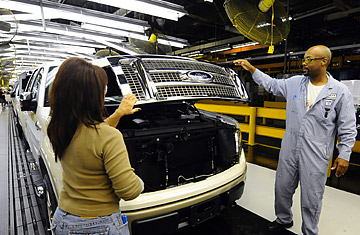
Workers assemble a truck at the Kansas City Ford Assembly plant in Claycomo, Mo.
President Bush's fiscal lifeline for GM and Chrysler, announced at the White House Friday morning, amounts to a $13.4 billion handoff to the incoming Administration of President-elect Obama. The deal is rife with indistinct targets the automakers must meet to avoid being forced to repay the loan in three months, squishy conditions for union sacrifices and a deadline that can be changed under numerous circumstances. And of course the entire thing can be renegotiated at will by the incoming Administration.
The massive loan is just the latest move in a long game of high-stakes hot potato involving Detroit, Congress, the White House and the incoming Administration. Obama first asked Bush to do something to save the auto companies in their initial meeting after the Nov. 4 election, but Bush rebuffed him. The problem then went to Capitol Hill, where it spent two weeks getting ground down, spiced up and stuffed into legislative packaging, only to have the whole sausage thrown out when the Senate failed to move the bill before adjourning for the holidays. (See pictures of the remains of Detroit.)
The auto companies then did their part, with Chrysler recently announcing it would shut down operations for a full month, raising the threat of catastrophic liquidation if someone in Washington didn't cough up some money. Bush's hand was forced. In theory, the job of saving the car companies would have gone to the Commerce Department, but its chief, Carlos Gutierrez, doesn't have access to the kind of money Detroit needs, so Bush gave the job to Treasury Secretary Hank Paulson.
Thursday night, Treasury's interim chief investment officer of the $700 billion bailout fund, Jim Lambright, and his team of crisis managers hunkered down with representatives of GM and Chrysler and worked all night to finalize the details of the deal. The result does its best to impose order on what would otherwise be the disorderly bankruptcies of the two companies, but in many regards it just passes the buck to Obama. To be fair, Treasury had but a week to address an incredibly complex problem and come up with a multibillion-dollar aid package — no small achievement, however lacking in teeth. (Read "In the Nick of Time: Bush Announces Auto Bailout.")
The plan will move $13.4 billion in funds from the Troubled Asset Relief Program (TARP) to GM and Chrysler, with GM getting $9.4 billion and Chrysler $4 billion. The money will be in the form of three-year loans, but the terms permit the Obama Administration to demand earlier repayment — presumably triggering bankruptcy — if it believes the restructuring goals are not being met. The near-term target is a March 31 deadline for the automakers to show a plan for achieving long-term viability. Based on White House and Treasury descriptions of the plan, this will be less an acid test than a subjective assessment of progress.
Borrowing heavily from features of the failed House and Senate plans, the Treasury plan requires that labor costs be on par with those of the nonunionized automakers but gives the companies until the end of 2009. It eliminates the job bank and requires that half of the future payments to the retiree health-care trust, VEBA, be made with stock. Further, it requires that debt be cut by two-thirds through a debt-for-equity exchange. Though these are terms of the loan, they are described as "targets," meaning exceptions can be made if there is deemed to be a good reason to do so.
In the event of a bankruptcy-filing down the road, Treasury (i.e., taxpayers) will stand behind senior secured lenders, getting first claim on the automakers' unencumbered assets, those not already pledged to a prior lender. GM says it has such assets — power trains, some foreign operations — and Chrysler says it has assets to secure the loans as well. As with other TARP assists, the government will also receive warrants that (theoretically, at least) could pay off one day.
There is another story in all this, of course. President Bush is approaching Hoover-Buchanan levels of end-of-office ignominy. His evident discomfort at unveiling the auto plan Friday morning comes, in part, from the ideological anomie he feels at the massive government intervention in a once major part of the American economy. But what must hurt even more for Bush — who has always had a keen sense of political reality, whatever his other shortcomings — is the self-image of a President stepping before the podium in his last days to announce a stopgap rescue for two giant, collapsing pillars of American industry. The auto companies may have gotten their shot at a rebound today, but Bush's place in history got at best a dead-cat bounce.
